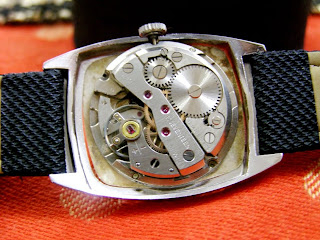




DESCRIPTION
| BRAND | : RICOH |
| MODEL | : RICOH 9 - 21 JEWELS |
| AGE OF THE WATCH | : 1970's |
| FEATURES | : 1. TWO COLOUR 2. BLACK/MAROON COLOUR - ORIGINAL DIAL WITH DAY & DATE ON FIG 3. RICOH MARK ON CROWN. STAINLESS STEEL CASE & BACK, RICOH MARK & SIGN ON BACK, SERIAL # 061822. 21 JEWELS MOVEMENT. EXCELLENT CONDITION MOVEMENT. NEWLY INSTALLED 18MM BROWN LEATHER BAND. |
| MOVEMENT TYPE | : AUTOMATIC - 21 JEWELS MOVEMENT, MOVEMENT RECENTLY SERVICED IN FULL WORKING ORDER & KEEPING GOOD TIME. |
| CASE & BACK | : STAINLESS STEEL CASE & BACK. |
| CRYSTAL | : MINERAL CRYSTAL |
| CASE DIAMETER | : 35MM WITHOUT CROWN |
| CASE SIZE LUG TO LUG | : 40MM LUG TO LUG |
| DIAL | : TWO COLOUR ORIGINAL DIAL WITH DAY & DATE AT 3:00 |
| BELT (STARPS) | : NEWLY INSTALLED 18MM BELT. |
| MADE | : JAPAN |
| PRICE | : SOLD TO SHEIKH SAIFUL, FROM PJ |
| HOW TO USE IT | : DAY/DATE : Push the upside button to change date individually. : Move the hands for 24 hours to change Day/Date. |
BRIEF HISTORY OF RICOH WATCHES
May 1962 - Ohmori Plant and General Research Laboratory completed.
Apr. 1, 1963 - Name changed (again) to Ricoh Co., Ltd.
May 1967 - Ginza Office established.
Mr. Kiyoshi Ichimura [or Itimura] is shown as having a growing career within this company, as well as having various business leadership roles outside Ricoh. From the Fact Book,
Feb. 2, 1936 Kiyoshi Ichimura appointed executive managing director [until Jan. 11, 1946]
Jan. 12, 1946 Kiyoshi Ichimura appointed president [until Dec. 16, 1968]
Per Hokkaido, he died November 17, 2004 of chronic hepatitis per Hokkaido, but per the 2006 Fact Book: "Dec. 16, 1968 Founder and President Kiyoshi Ichimura passed away" I'm inclined to believe the official Ricoh document on this one!!
It is not stated outright, but implied, that Ricoh took over (bought out) the ailing Takano firm.
In 1962, Hamilton entered into a joint venture (60% owned by Hamilton) with the Japanese watchmaking firm Ricoh to produce electric watches meant primarily for the Japanese market. The partnership was dissolved in 1965. See the "group entry" for Hamilton Ricoh watches for additional background information.



















